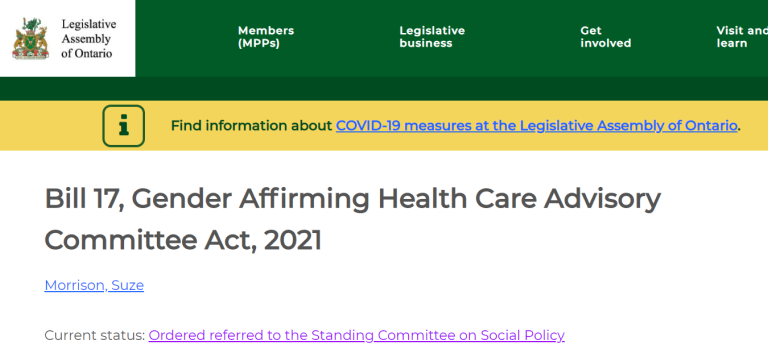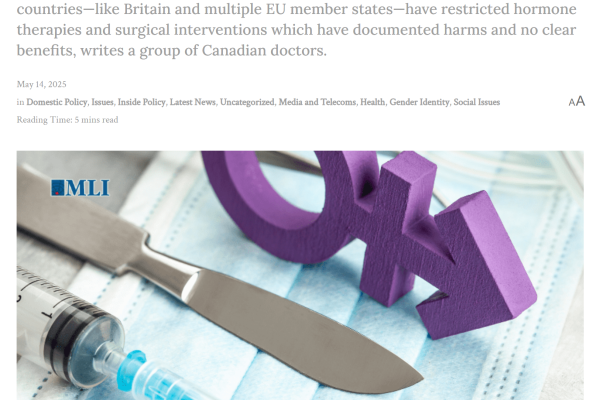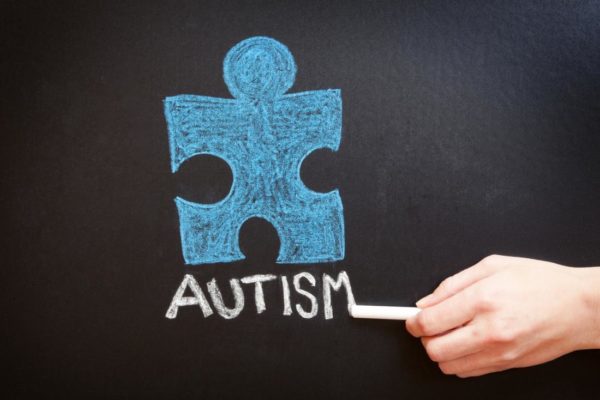Brief to the Standing Committee on Social Policy on Bill 17 – Gender Affirming Health Care Advisory Committee Act
Canadian Gender Report
November 8, 2021
Introduction
Canadian Gender Report has five concerns about the current bill:
- The committee’s name “Gender Affirming” implies a bias towards a particular model of gender health care that is coming under increasing scrutiny around the world because there is a lack of evidence to support it.
- The direction to the committee to implement an “informed consent model” of care refers to a model of care which is contrary to good medical practice.
- There is no provision for representation on the committee by detransitioners and others who have been harmed by inappropriate medical transition.
- The reference to gender affirming care as “life saving” is based on harmful misinformation concerning suicide risk and contravenes good suicide prevention practice.
- The committee includes representation of persons with Differences of Sex Development (referred to in the Bill as “intersex”) whose medical issues are different from people experiencing gender-related distress.
Affirming Care
All individuals deserve to be treated with dignity and respect. This is not up for debate. The model of “affirmation” being applied in our healthcare system, however, has evolved into a one-size-fits-all medicalization approach. Gender affirming care is a poorly understood model of care that is being applied to children and adolescents experiencing gender dysphoria. The “affirming care” approach dictates that medical interventions such as puberty blockers, cross-sex hormones and irreversible surgeries be provided to youth based on their self-directed gender “goals”.
The previously established clinical protocol of watchful waiting provided a supportive approach whereby children can be gently questioned about why they have started to identify as a different gender. It allowed parents, clinicians, and others to develop a complete picture of the child’s needs and keep all options open to help the child resolve feelings of gender dysphoria without pushing them towards irreversible medical interventions. This more cautious model of care has been phased out in favour of “affirmation” at Canadian gender clinics despite no evidence of improved health outcomes.
The affirming model of care is risky because it does not allow a healthcare professional to explore how underlying factors may be contributing to a young person’s newly adopted gender identity and feelings of gender dysphoria. Issues such as childhood trauma, psychiatric symptoms such as cutting or self-harm behaviours, autism or ADHD, feelings of shame due to same-sex attraction and many other issues a young person may be struggling with are often entangled with symptoms of gender dysphoria.
When the American Academy of Pediatrics in 2018 endorsed the affirming care model, Dr. James Cantor reviewed the supporting materials and concluded that the recommendations were made not only without evidence but “despite” the existing evidence.[1]
Although the number of children and youth receiving gender affirming care has been increasing rapidly, the quality of the supporting evidence has not improved. A recent article in Medscape by Will Malone MD, reviews the current state of the evidence.[2] Here are some of his key points:
- Over the last 10 years there have been increases of over 1,000 percent in the number of children and youth appearing at gender clinics and the reasons for this are not well understood.
- Studies done before the affirming model took hold found that most children showing symptoms of gender dysphoria would desist around puberty. In many cases, they would grow up to be gay or lesbian.
- There have been no studies of patients whose gender dysphoria first appeared during puberty, even though these patients are increasingly common.
- Many detransitioners first experienced gender dysphoria as teenagers.
- There is no evidence that early social transition (change of name and pronouns) improves mental health outcomes but there is evidence that it increases the chance that a child will persist and proceed to medical transition.
- Nearly 100% of children who begin puberty blockers will proceed to cross sex hormones and surgeries.
- The long term health risks of treatment with puberty blockers and cross sex hormones from a young age are largely unknown.
- The current medical model of “affirming care” is based on a single Dutch study of 55 young people with severe gender dysphoria from childhood. Many of the children presenting at gender clinics today first experienced gender dysphoria post-puberty or have comorbid mental health conditions. Both of these factors would have disqualified them from the initial Dutch study.
- No researchers have replicated the results of this Dutch study and there has been no long term follow up of this patient group.
Clinicians around the world are beginning to re-think their approach to gender dysphoria and are moving towards treatment models which place more stress on psychotherapy and less on medical transition.
The Royal Australian and New Zealand College of Psychiatrists recently issued a position statement on the mental health needs of people experiencing gender dysphoria. The policy acknowledges that the treatment of gender dysphoria in children and adolescents has been impacted by “polarised socio-political discourse.” The policy notes that there are multiple perspectives and views and does not endorse any specific guidelines for treatment. It notes that “evidence and professional opinion is divided as to whether an affirmative approach should be taken in relation to treatment of transgender children or whether other approaches are more appropriate.” [3] It emphasizes that psychotherapy has a role in the treatment of both children and adults.
In the United States, Dr. Marci Bowers, who is a leading transgender surgeon, and the incoming president of the World Professional Association for Transgender Health (WPATH) recently gave an interview in which she expressed concern that blocking puberty at too young an age makes surgery more complicated and risks leaving patients incapable of orgasm. Psychologist Erica Anderson talked about “sloppy” practices in gender clinics which are rushing patients to hormone therapy without adequate assessment. [4]
WPATH plans to issue new standards of care for transgender health in December, 2021.
In 2020 the Finnish Health Authority issued new guidelines for the treatment of gender dysphoria in minors which recommended that psychosocial support should be the first line of treatment. Puberty blockade and hormone therapy are permitted only in cases of severe and persistent distress.[5]
Sweden’s National Board of Health and Welfare is also conducting a review of hormonal treatment for gender dysphoric young people. In the interim, five of the country’s six pediatric gender clinics have agreed not to provide medical transition treatment for minors outside of clinical trials. [6] Sweden has thereby recognized the need for long-term monitoring and evaluation of different approaches to ensure that the goal of long-term health is prioritized and that the needs of young people seeking gender transition can be better understood.
The United Kingdom is also conducting an independent review of gender identity services for children and youth.[7] As part of this review, the National Institute for Care Excellence conducted evidence reviews for the use of puberty suppression and cross sex hormones and found that the evidence in support of both is low quality. [8] The overall review is intended to be underpinned by research and evidence with no pre-determined outcomes as to recommendations.
The Ontario government should adopt the same evidence-based approach to gender healthcare. The committee’s name and mandate should be changed to make it clear that it is not tied to any particular model of care.
Informed Consent
The “informed consent” model which the bill intends to implement goes well beyond the affirming care model. Informed consent in gender medicine has a meaning which is very different from the meaning of informed consent in medical law. In ordinary medical practice, a patient consents to a treatment proposed by a medical practitioner after receiving a diagnosis. The practitioner has a duty to ensure that the patient is fully informed of the effects of the treatment including any side effects, alternative diagnoses, and alternative treatments, including the possibility of no treatment.
In transgender healthcare the term “informed consent model” is a term of art. There are many variations of the informed consent model for gender healthcare, but their key feature is that they reject the idea that a diagnosis of gender dysphoria or any other condition is needed in order to start the medical transition process. They start from the assumption that clinicians must respect patients’ self declared sense of gender identity and provide the patients with access to whatever services they desire to align their bodies with their evolving identity, provided only that the patients understand and accept the medical risks.[9]
The problem with this version of the informed consent model is that it fails to differentiate between respecting a patient’s sense of identity and accepting it at face value. A therapist or physician can respect the reality of a patient’s feelings and sense of distress without abandoning the professional responsibility to provide diagnosis and treatment which is in fact in the best interests of the patient. Real informed consent requires more than simply requiring the patient to sign a form listing the possible side effects of a treatment.
Patients need to understand the overall effects of the treatment and the availability, risks and benefits of alternative treatments. They also need to explore whether their sense of distress over their sex characteristics is the result of depression, an autism spectrum condition, anorexia, body dysmorphia disorder or some other mental health condition. Patients cannot be said to give truly autonomous consent to a treatment unless they understand both their conscious and unconscious motives for transition and this requires exploratory therapy.[10]
The informed consent model is wholly inappropriate for children and adolescents for several reasons. First, it is unethical to consider a young person who has not reached sexual maturity or experienced an orgasm to understand the real possibility that they will never be able to experience sexual pleasure and expect them to be able to sign off on this as a mere “side effect” of treatment. Second, it is very likely unlawful to expect children and young people to consent to treatments for which the experts themselves do not fully understand the risks and benefits. This is problematic even for mature minors and young adults. Studies of brain maturation have found that the human brain is not fully mature until around age 25 and the capacity for long term decision making and risk assessment is one of the last things to develop.[11]
The recent Kiera Bell case in the UK examined this issue and the determination, after appeal, is that young people do not have capacity to consent to this form of medical treatment.[12] While the result of the appeal process was to remove the requirement for a “best interest court order” prior to any child being referred to a gender clinic in the UK, the legal landscape in the UK has nonetheless evolved such that the physicians are responsible for approving the treatments, rather than the child.[13] This is a significant legal and ethical distinction that requires close examination in our Canadian context. This brings us to the third problem with informed consent as it is being proposed for children and young people which is the power imbalance that exists between a child and a physician who is offering and prescribing these life-altering medical interventions as a trusted authority. Many detransitioners are emerging from the cohort who transitioned under an informed consent model without adequate psychological assessment. Some of them are even stating that they felt pressured into transitioning.[14]
Detransitioners
There are a growing number of people who regretted their decision to attempt gender transition and are now de-transitioning. Two detransitioners from the United Kingdom were recently interviewed on CTV W5.[15] Detransitioners in Canada are beginning to organize. A group submitted a brief to the Justice Committee on Bill C-6 last fall.[16] Research on detransition is just beginning but two recent studies have identified some of their needs and concerns.[17]
The existence of detransitioners undermines one of the key assumptions of the informed consent model which is that people have a stable sense of gender identity. The majority of detransitioners say that they have not been well served by the current system of gender affirming care which allowed them to transition without full exploration of their psychological condition. In one of the studies of detransition the top three reasons for detransitioning were:
- Realized that my gender dysphoria was related to other issues (70%)
- Health concerns (62%)
- Transition did not help with my dysphoria (50%)
Detransitioners often have ongoing medical needs related to their transition as well as psychological needs for the mental health concerns that their transition did not resolve. They are reluctant to go back to the clinics which enabled their transition. They say that the clinicians ignored their underlying mental health problems and simply focused on gender transition as a quick fix. (This is one of the reasons that gender clinics tend to report low rates of detransition.) Where detransitioners require further medical services they are often not covered. The Bill refers to providing coverage or electrolysis for transition. If this is covered, there should also be coverage when it is needed for detransition.
Detransitioners should be represented on the committee and the committee given directions to develop recommendations for better services for detransition, including non-medical services such as supportive psychotherapy funded by OHIP.
Misrepresentation of Suicide Risk
The statement that gender affirming care is “life saving” is based on the harmful myth that people with gender dysphoria will die by suicide if they are not allowed medical transition.
The language in the bill violates the basic principles of suicide prevention which are set out in the media guidelines of the Canadian Psychiatric Association. It is well known that suicidal thoughts can spread by social contagion. Reporting on suicides should not be sensational or excessive and should avoid simplistic explanations which attribute suicide to a single cause. It is highly irresponsible to make a statement in legislation which implies that a vulnerable population will be at risk of suicide unless they receive a specific medical intervention.[18]
Questionable suicide statistics like the claim that 41% of transgender people have attempted suicide are regularly quoted by activists and repeated in the press with little scrutiny when they are in fact based on highly flawed data.[19] There is no doubt that people experiencing gender dysphoria are at a higher risk for suicide than the general population, but this reflects the high level of comorbid mental health conditions found in the transgender population. Suicide risk remains high at every stage of gender transition.[20] There is no evidence that medical transition reduces suicide risk.
“Intersex” (DSD) Conditions
The inclusion of members of the so-called intersex community on the committee will lead to conflict and confusion. The term intersex is an umbrella label which has been applied to over 40 distinct conditions affecting sexual development. The term intersex is controversial. Some people with one of these conditions continue to use it but others prefer to use Disorders / Differences of Sexual Development (DSD), Variations of Sexual Development (VSD) or Congenital Conditions of Sexual Development (CCSD). Differences of Sexual Development are not a third sex or part of a spectrum between male and female, but variations of the male or female developmental path.
A blog post entitled The Invention of Intersex provides detailed discussion of DSD conditions. The author is an activist from the United Kingdom living with Complete Androgen Insensitivity Syndrome. She argues that attempting to deal with DSD conditions as part of the LGBTQ umbrella promotes confusion and makes it difficult to discuss the specific medical needs of people with various DSD conditions.[21]
The references to “intersex” should be removed from the bill and the government should set up a specific advisory committee for DSD issues in consultation with the DSD community.[22]
Recommendations
- Rename the Committee to the Gender Health Care Committee (strike “affirming”).
- Amend clause (7) of subsection 3(2) to read: How to develop evidence-based standards of care based on best international practices for all aspects of transgender care.
- Delete clause (8) of subsection 3(2) and replace with the following: How to create and enhance services for persons who wish to halt or reverse their gender transition.
- Amend clause (8) of subsection 3(2) to refer to both transition and detransition.
- Add “detransitioners” to the list of communities to be represented on the committee in subsection 2(5)
- Delete all references to “intersex” from the Bill and recommend the establishment of a separate committee to advise the Minister on issues relating to persons with Difference of Sex Development conditions.
- Establish an independent and multi-disciplinary committee of experts to evaluate the current evidence base for transgender healthcare models of care under which Ontario children and young people are receiving treatment and create a mechanism to regularly review the health outcomes of this population, including an understanding of the impact of co-occurring mental health issues on long term well-being, over a period of 10 years or more.
References:
[1] James Cantor, “American Academy of Pediatrics Policy and Trans- Kids: Fact-Checking,” 2018, http://www.sexologytoday.org/2018/10/american-academy-of-pediatrics-policy.html .
[2] William J Malone, “Time to Hit Pause on ‘Pausing’ Puberty in Gender-Dysphoric Youth,” Medscape (blog), September 17, 2021, https://www.medscape.com/viewarticle/958742
[3] The Royal Australian and New Zealand College of Psychiatrists, “Recognising and Addressing the Mental Health Needs of People Experiencing Gender Dysphoria / Gender,” September 2021, https://www.ranzcp.org/news-policy/policy-and-advocacy/position-statements/gender-dysphoria .
[4] Abigail Shrier, “Top Trans Doctors Blow the Whistle on ‘Sloppy’ Care,” Substack newsletter, Common Sense with Bari Weiss (blog), October 4, 2021, https://bariweiss.substack.com/p/top-trans-doctors-blow-the-whistle .
[5] “One Year Since Finland Broke with WPATH ‘Standards of Care,’” Society for Evidence Based Gender Medicine (blog), July 2, 2021, https://segm.org/Finland_deviates_from_WPATH_prioritizing_psychotherapy_no_surgery_for_minors .
[6] “All Six of Sweden’s Pediatric Clinics Meet to Discuss a Cautious Stance Toward Pediatric Gender Transitions,” Society for Evidence Based Gender Medicine (blog), September 9, 2021, https://segm.org/Swedish_pediatric_gender_clinics_adopt_cautious_stance .
[7] “Cass Review – Independent Review of Gender Identity Services for Children and Young People,” accessed October 8, 2021, https://cass.independent-review.uk/ .
[8] National Institute for Health and Care Excellence, “Evidence Review: Gender-Affirming Hormones for Children and Adolescents with Gender Dysphoria10?” (National Institute for Health and Care Excellence, 2020), https://t.co/E0rwGKkrwN?amp=1 ; National Institute for Health and Care Excellence, “Evidence Review: Gonadotrophin Releasing Hormone Analogues for Children and Adolescents with Gender Dysphoria” (National Institute for Health and Care Excellence, 2020), https://t.co/tLyPFblrMD?amp=1 ; National Institute for Health and Care Excellence, “Evidence Review: Gender-Affirming Hormones for Children and Adolescents with Gender Dysphoria10?”
[9] Florence Ashley, Colton M St. Amand, and G Nic Rider, “The Continuum of Informed Consent Models in Transgender Health,” Family Practice 38, no. 4 (August 1, 2021): 543–44, https://doi.org/10.1093/fampra/cmab047
[10] Alessandra Lemma and Julian Savulescu, “To Be, or Not to Be? The Role of the Unconscious in Transgender Transitioning: Identity, Autonomy and Well-Being,” Journal of Medical Ethics, July 29, 2021, https://doi.org/10.1136/medethics-2021-107397 .
[11] Suzanne O’Rourke et al., “The Development of Cognitive and Emotional Maturity in Adolescents and Its Relevance in Judicial Contexts : Literature Review” (Scottish Sentencing Council, February 2020), https://www.scottishsentencingcouncil.org.uk/media/2044/20200219-ssc-cognitive-maturity-literature-review.pdf .
[12] R (on the application of) Quincy Bell and A -v- Tavistock and Portman NHS Trust and others, EWHC 3274 (High Court of Justice, Administrative Court 2020). https://www.judiciary.uk/judgments/r-on-the-application-of-quincy-bell-and-a-v-tavistock-and-portman-nhs-trust-and-others/
[13] R (on the application of) Quincy Bell and A -v- Tavistock and Portman NHS Trust and others, [2021] EWCA Civ 1363 (Court of Appeal) https://www.judiciary.uk/wp-content/uploads/2021/09/Bell-v-Tavistock-judgment-170921.pdf
[14] Lisa Littman, “Individuals Treated for Gender Dysphoria with Medical and/or Surgical Transition Who Subsequently Detransitioned: A Survey of 100 Detransitioners,” Archives of Sexual Behavior, October 19, 2021, https://link.springer.com/article/10.1007%2Fs10508-021-02163-w .
[15] “The Transition,” W5 (CTV, October 23, 2021), https://youtu.be/nBiD1CPatGQ .
[16] Detrans Canada, “Brief to the House of Commons Standing Committee on Justice and Human Rights Regarding Bill C-6,” September 12, 2020, https://www.ourcommons.ca/Content/Committee/432/JUST/Brief/BR11002561/br-external/DetransCanada-e.pdf .
[17] Elie Vandenbussche, “Detransition-Related Needs and Support: A Cross-Sectional Online Survey,” Journal of Homosexuality 0, no. 0 (April 30, 2021): 1–19, https://www.tandfonline.com/doi/abs/10.1080/00918369.2021.1919479 ; Lisa Littman, “Individuals Treated for Gender Dysphoria with Medical and/or Surgical Transition Who Subsequently Detransitioned: A Survey of 100 Detransitioners,” Archives of Sexual Behavior, October 19, 2021, https://link.springer.com/article/10.1007%2Fs10508-021-02163-w .
[18] Mark Sinyor et al., “Media Guidelines for Reporting on Suicide: 2017 Update of the Canadian Psychiatric Association Policy Paper,” The Canadian Journal of Psychiatry 63, no. 3 (March 2018): 182–96, https://doi.org/10.1177/0706743717753147 .
[19] “The 41% Trans Suicide Attempt Rate: A Tale of Flawed Data and Lazy Journalists,” 4thWaveNow (blog), August 3, 2015, https://4thwavenow.com/2015/08/03/the-41-trans-suicide-rate-a-tale-of-flawed-data-and-lazy-journalists/ .
[20] C. M. Wiepjes et al., “Trends in Suicide Death Risk in Transgender People: Results from the Amsterdam Cohort of Gender Dysphoria Study (1972–2017),” Acta Psychiatrica Scandinavica 141, no. 6 (2020): 486–91, https://onlinelibrary.wiley.com/doi/abs/10.1111/acps.13164
[21] Clarecais, “The Invention of Intersex,” Differently Normal (blog), October 25, 2021, https://differently-normal.com/2021/10/25/the-invention-of-intersex /.
[22] We are not aware of any Canadian DSD groups but these are two international organizations that might assist. “About :: DSD Families,” dsd, accessed October 31, 2021, https://www.dsdfamilies.org/ ; “Intersex Society of North America | A World Free of Shame, Secrecy, and Unwanted Genital Surgery | Intersex Society of North America,” accessed October 31, 2021, https://isna.org/ .




